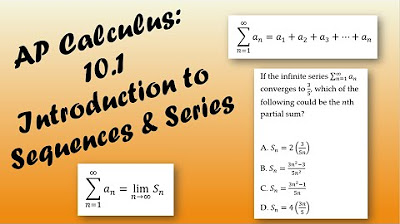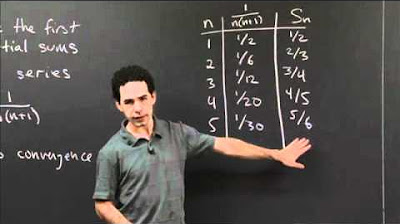Partial sums intro | Series | AP Calculus BC | Khan Academy
TLDRThis video script introduces the concept of an infinite series and its partial sums. It explains how to calculate the partial sum of the first 'n' terms of a series, using the example of the sum of reciprocals of squared numbers. The script also demonstrates algebraic expression for partial sums and applies it to find the sum of the first six terms of a given series, emphasizing the importance and utility of understanding partial sum notation.
Takeaways
- 🧮 The script introduces the concept of an infinite series, denoted as S, which is the sum from n equals 1 to infinity of a sub n.
- 🔢 An infinite series can be expressed as a sub 1 + a sub 2 + a sub 3 and so on, continuing indefinitely.
- 📝 The idea of a partial sum is introduced, representing the sum of the first n terms of an infinite series.
- 📏 S sub n is the notation for the partial sum of the first n terms.
- 💡 To make the concept tangible, the script uses the example of the series sum from n equals 1 to infinity of 1 over n squared.
- 📊 The partial sum S sub 3, for example, would be the sum of the first three terms: 1 + 1/4 + 1/9.
- 🔍 Calculating S sub 3 involves finding a common denominator and adding the terms to get 49/36.
- 🧠 The script explains that partial sums can be expressed algebraically, such as S sub n being equal to (n squared - 3) / (n cubed + 4).
- 🔎 Given a partial sum formula, you can determine the sum of the first n terms of the series by substituting n into the formula.
- 📐 For example, to find the sum of the first 6 terms (S sub 6), substitute 6 into the formula to get 33/220.
Q & A
What is an infinite series?
-An infinite series, denoted as S, is the sum of a sequence of terms 'a_sub_n' from n=1 to infinity, represented as S = Σ (a_sub_n) from n=1 to infinity.
What is a partial sum in the context of an infinite series?
-A partial sum, denoted as S_sub_n, is the sum of the first n terms of an infinite series, essentially a finite version of the infinite series up to the nth term.
How is the partial sum of an infinite series different from the series itself?
-The partial sum is a finite sum of the first n terms of the series, whereas the infinite series is the sum of all terms from n=1 to infinity, which theoretically continues forever.
What is the formula for the partial sum S_sub_n given in the script?
-The formula for the partial sum S_sub_n given in the script is n^2 - 3/n^3 + 4.
How would you calculate S_sub_three for the series 1/n^2?
-To calculate S_sub_three for the series 1/n^2, you would add the first three terms: 1/1^2 + 1/2^2 + 1/3^2, which simplifies to 1 + 1/4 + 1/9, and the sum is 49/36.
What is the significance of understanding partial sums in the study of series?
-Understanding partial sums is crucial as it allows for the analysis of the behavior of a series over a finite number of terms, which can be helpful in determining convergence and other properties of the series.
How can you algebraically evaluate S_sub_six using the given formula for the partial sum?
-You can algebraically evaluate S_sub_six by substituting n with 6 in the given formula: 6^2 - 3/6^3 + 4, which simplifies to 36 - 3/216 + 4, resulting in 33/220.
What is the purpose of introducing the concept of partial sums in the script?
-The purpose of introducing the concept of partial sums is to help viewers appreciate the idea of summing a finite number of terms in an infinite series and to understand how it can be expressed algebraically.
What does the subscript notation 'a_sub_n' represent in the context of series?
-The subscript notation 'a_sub_n' represents the nth term in the sequence of an infinite series.
Can the partial sum of an infinite series ever equal the sum of the series itself?
-In some cases, if the infinite series converges, the value of the series can be approached by the value of its partial sums as n becomes very large, but the partial sum itself is finite and does not equal the infinite sum.
How does the script illustrate the concept of a common denominator in the calculation of partial sums?
-The script illustrates the concept by adding the first three terms of the series 1/n^2, where it finds a common denominator (36 in this case) to sum the fractions, resulting in 49/36.
Outlines
📚 Introduction to Infinite Series and Partial Sums
This paragraph introduces the concept of an infinite series, denoted as S, which is the sum of a sequence \( a_n \) from \( n = 1 \) to infinity. The idea of a partial sum is explained, which is the sum of the first \( n \) terms of the series, represented as \( S_n \). An example is given where the series is the sum of \( 1/n^2 \), and the viewer is encouraged to calculate \( S_3 \). The calculation is then shown, resulting in \( 49/36 \). The paragraph emphasizes the importance of understanding partial sums and sets the stage for algebraic expressions of partial sums.
🔍 Algebraic Expression of Partial Sums and Example Calculation
Building on the previous explanation, this paragraph delves into the algebraic representation of partial sums. It provides an example where the partial sum \( S_n \) is given by an algebraic expression: \( n^2 - 3/n^3 + 4 \). The viewer is then challenged to find the sum of the first six terms of the series using this formula. The calculation is performed, substituting \( n \) with 6, resulting in \( 33/220 \). This demonstrates the practical application of the partial sum formula and reinforces the understanding of the notation and its significance in series analysis.
Mindmap
Keywords
💡Infinite series
💡Partial sum
💡S sub n
💡Formula for partial sum
💡a sub n
💡Sum from n equals 1 to infinity
💡Common denominator
💡S sub 6
💡Evaluation of S sub 6
💡n to the third power
Highlights
Introduction of the concept of an infinite series S and its representation as the sum of a sub n from n equals one to infinity.
Explanation of a partial sum as the sum of the first n terms of an infinite series.
Illustration of how to calculate a partial sum with the example of S sub six.
Demonstration of the infinite series S as the sum of one over n squared from n equals one to infinity.
Calculation of S sub three using the series of one over n squared.
The result of S sub three being 49/36, showcasing the process of finding a partial sum.
Introduction to the algebraic expression of a partial sum for a given infinite series.
Use of an algebraic formula to represent the partial sum S sub n in terms of n squared, n cubed, and constants.
A hypothetical scenario where the partial sum formula is applied to find the sum of the first six terms of an infinite series.
The process of substituting n with six in the given algebraic formula to find S sub six.
Calculation of six to the third power as part of finding S sub six.
Final calculation of S sub six resulting in the value of 33/220.
Emphasis on the importance of understanding and appreciating partial sum notation.
The practical application of partial sum notation in evaluating infinite series.
The significance of the video in helping viewers grasp the concept of partial sums in series.
Encouragement for viewers to pause and work through the calculations themselves to enhance understanding.
The use of color coding in the video to distinguish between different steps of the explanation.
Transcripts
Browse More Related Video

AP Calculus BC Lesson 10.1

Partial sums: term value from partial sum | Series | AP Calculus BC | Khan Academy

Limit of a Series | MIT 18.01SC Single Variable Calculus, Fall 2010

Unit VII: Lec 1 | MIT Calculus Revisited: Single Variable Calculus

Arithmetic Series (Precalculus - College Algebra 70)

Infinite series as limit of partial sums | Series | AP Calculus BC | Khan Academy
5.0 / 5 (0 votes)
Thanks for rating: